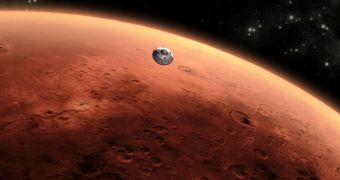The Mars Science Laboratory (MSL) is currently less than 65 days away from reaching the Red Planet, mission managers at the NASA Jet Propulsion Laboratory, in Pasadena, California, announced.
The spacecraft comprises an aeroshell, the rover Curiosity and the Sky Crane system. The latter will be in charge of lowering the explorations robot onto the actual surface of the planet, while it hovers several meters in the air.
Since its November 8, 2011 launch, the mission has remained on track and on schedule, completing its in-flight milestone without any glitch. Experts have high hopes that the vehicle will continue to perform admirably in the coming months as well.
JPL scientists say that the vehicle is scheduled to touch down at the base of Mount Sharp, inside the massive Gale Crater, on the night of August 5 (EDT), or August 6 (UTC), Space reports.
Curiosity is the size of a Mini Cooper, and weighs a little less than a ton. It is by far the largest rover or lander ever to be deployed on our neighboring planet, and dwarfs the Mars Exploration Rovers Spirit and Opportunity by comparison.
The MSL mission also has the steepest angle of atmospheric entry of any missions NASA sent to the Red Planet. For several minutes, as the spacecraft makes its way through the upper layers of the Martian atmosphere, JPL mission controllers will be unable to contact the vehicle.
“Landing an SUV-sized vehicle next to the side of a mountain 85 million miles from home is always stimulating. Our engineering and science teams continue their preparations for that big day and the surface operations to follow,” JPL Curiosity project manager, Pete Theisinger, said in a statement.
After nearly a decade of planning and construction, the $2.5 billion spacecraft is finally getting ready to achieve its objective. Its main mission is to figure out whether the area at Gale Crater ever supported, or was able to support, even basic lifeforms.
The rover carries a suite of 10 advanced scientific instruments to help it determine whether that was the case. These include a laser capable of zapping an object up to 10 meters (32 feet) away. A spectrometer then analyzes the pulverized materials, assessing its chemical composition.
When Curiosity lands, NASA will again have two rovers operating on the Red Planet at the same time. Previously, the MER robots Spirit and Opportunity shared this distinction, but the former has since failed, and is now abandoned. The latter is continuing its scientific investigations at Endeavour Crater.

 14 DAY TRIAL //
14 DAY TRIAL //